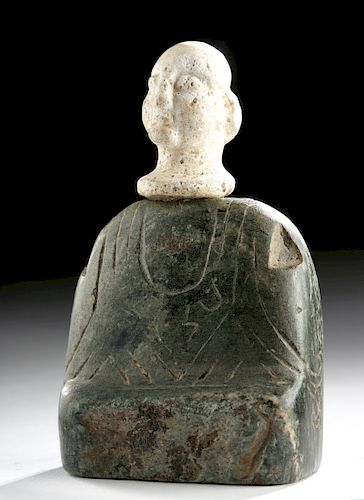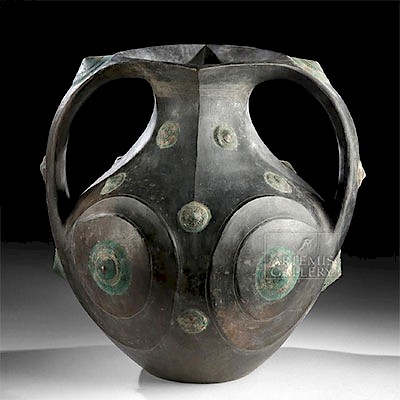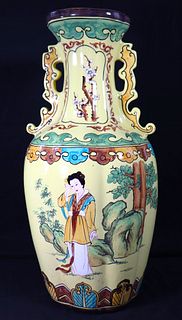Bactrian Stone Idol - Body and Head
Lot 89
About Seller
Artemis Gallery
686 S Taylor Ave, Ste 106
Louisville, CO 80027
United States
Selling antiquities, ancient and ethnographic art online since 1993, Artemis Gallery specializes in Classical Antiquities (Egyptian, Greek, Roman, Near Eastern), Asian, Pre-Columbian, African / Tribal / Oceanographic art. Our extensive inventory includes pottery, stone, metal, wood, glass and textil...Read more
Categories
Estimate:
$1,500 - $2,000
Absentee vs Live bid
Two ways to bid:
- Leave a max absentee bid and the platform will bid on your behalf up to your maximum bid during the live auction.
- Bid live during the auction and your bids will be submitted real-time to the auctioneer.
Bid Increments
| Price | Bid Increment |
|---|---|
| $0 | $25 |
| $300 | $50 |
| $1,000 | $100 |
| $2,000 | $250 |
| $5,000 | $500 |
| $10,000 | $1,000 |
| $20,000 | $2,500 |
| $50,000 | $5,000 |
| $100,000 | $10,000 |
| $200,000 | $20,000 |
About Auction
By Artemis Gallery
Jul 11, 2019
Set Reminder
2019-07-11 10:00:00
2019-07-11 10:00:00
America/New_York
Bidsquare
Bidsquare : Ancient / Ethnographic / Americana
https://www.bidsquare.com/auctions/artemis-gallery/ancient-ethnographic-americana-4246
Discover ancient art from Egypt, Greece, Italy, and the Near East, as well as Asian, Pre-Columbian, Tribal, Fossils and Fine Art. Also featuring a wonderful collection from a prominent New York estate whose owners reside in the Van Wyck family's historic Lloyd Harbor waterfront home. Artemis Gallery info@artemisgallery.com
Discover ancient art from Egypt, Greece, Italy, and the Near East, as well as Asian, Pre-Columbian, Tribal, Fossils and Fine Art. Also featuring a wonderful collection from a prominent New York estate whose owners reside in the Van Wyck family's historic Lloyd Harbor waterfront home. Artemis Gallery info@artemisgallery.com
- Lot Description
Central Asia, Bactria-Margiana (BMAC) (Oxus Civilization), Bronze Age, ca. 2nd millennium BCE. A fascinating idol figure of a type found in present day Afghanistan, Turkmenistan, Tajikistan, and Uzbekistan, providing a window onto the religious beliefs of the ancient culture that flourished there over three thousand years ago. The head and the body were carved separately and may not have been intended for one another; however, both are ancient and work well together. The head was hand-carved from a white limestone and presents ovoid bulging eyes, an aquiline nose, closed lips, full cheeks, petite ears, a lobe of hair at the back, and a flared neckline. The body, carved from a deep green chlorite stone, is incised with a deep U-shaped neckline as well as curved and angled linear motifs designed to look like a kaunakes, or tufted garment, with a rounded front neckline and a divot at the top for fitting the head. Size: 1.625" L x 2.25" W x 3.75" H (4.1 cm x 5.7 cm x 9.5 cm)
The kaunakes was originally a Sumerian garment whose style migrated along the Silk Road and became popular in Bactria. Composite statuettes like this one, with the head composed of a different material than the body, have been found in the graves of women. Do they represent the individual buried, or are they deities?
Provenance: private California, USA collection, acquired over fifteen years ago
All items legal to buy/sell under U.S. Statute covering cultural patrimony Code 2600, CHAPTER 14, and are guaranteed to be as described or your money back.
A Certificate of Authenticity will accompany all winning bids.
We ship worldwide and handle all shipping in-house for your convenience.
#137575Head shows normal surface wear with minute nicks and abrasions to nose and high-pointed areas and a small loss to the neckline. A few chips to the body and back of body is rougher and not burnished as shown. Normal surface wear but nice surviving incised decoration on the front. Earthen and mineral deposits adorn both body and head.Condition
- Shipping Info
-
All shipping is handled in-house for your convenience. Your invoice from Artemis Gallery will include shipping calculation instructions. If in doubt, please inquire BEFORE bidding for estimated shipping costs for individual items.
-
- Buyer's Premium



 EUR
EUR CAD
CAD AUD
AUD GBP
GBP MXN
MXN HKD
HKD CNY
CNY MYR
MYR SEK
SEK SGD
SGD CHF
CHF THB
THB















